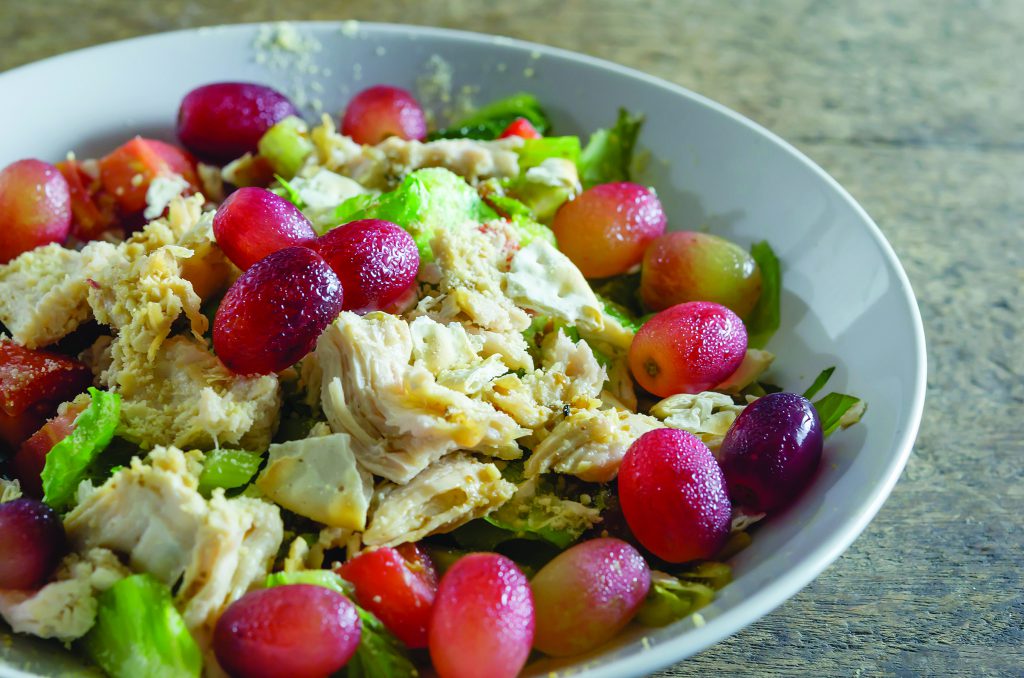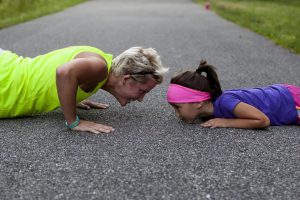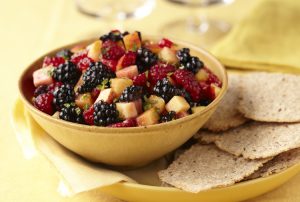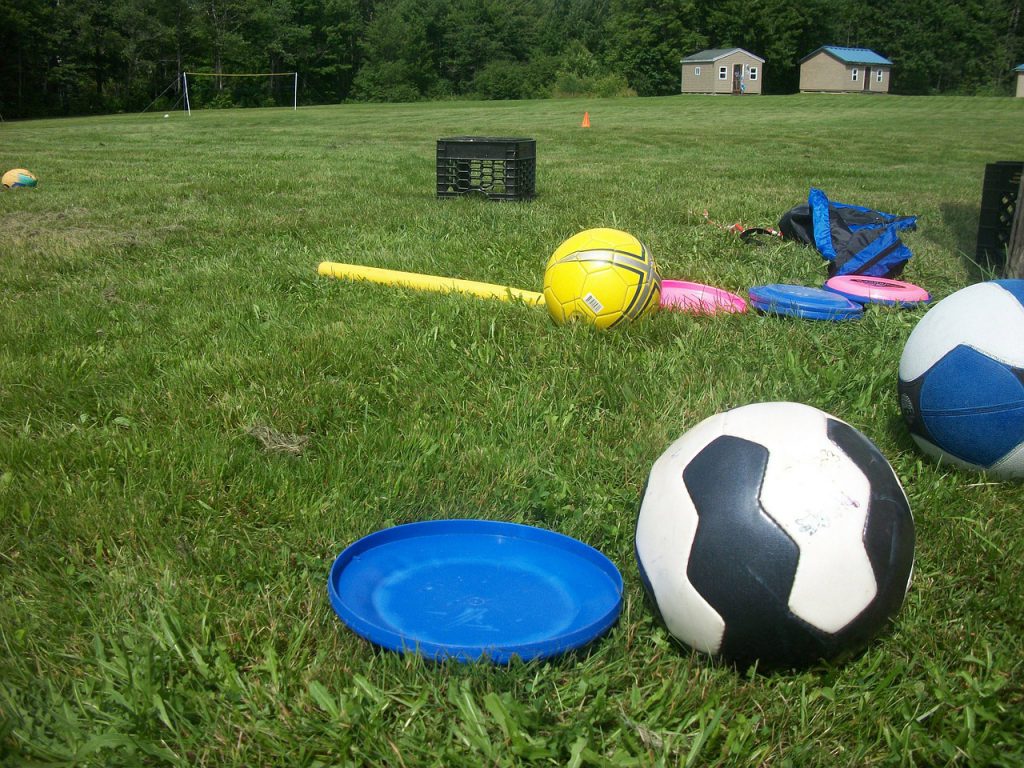Chicken and Fruit Salad

Make 8 Servings
Serving Size: 2/3 cup
Ingredients:
- 3 cups cooked chicken, chopped
- 1 (20 – ounce) can pineapple chunks in juice, drained well
- 1 (11-ounce) can mandarin oranges, in 100% fruit juice, drained
- 3/4 cup chopped celery
- 1 cup halved seedless grapes
- 1/4 cup low-fat mayonnaise
- 1/4 teaspoon black pepper
- 8 large lettuce leaves
Directions:
- in a large bowl, mix gently chicken, pineapple chunks, oranges, celery, and grapes.
- In a separate bowl, mix low-fat mayonnaise and black pepper.
- Gently stir mayonnaise into chicken mixture,
- Cover, and chill in the refrigerator.
- To serve, scoop 2/3 cup of chicken salad onto a lettuce leaf.
Strength Training for Children

Strength training is a vital type of physical activity that helps our muscles and bones grow stronger. Bone mass builds tremendously during childhood, and strength training is a great way to ensure children’s bones grow strong. Once children are old enough to play organized sports (usually around 7-8 years old), they can start participating in strength training. Children should participate in bone and muscle strengthening activities at least 2 days per week on nonconsecutive days for 20-30 minutes each session. And this time counts towards their 60 minutes of daily physical activity! Whether children use free weights, resistance bands, or their own body weight, they can safely strength train with appropriate adult supervision.
Since everyone’s body is different, there is no one strength training program that works for everyone. Typically, completing 1-3 sets (groups of repetitions with short rest periods in between) of 6-15 repetitions (the number of times you complete an exercise during a set) is appropriate for each exercise. Learn the proper form for each exercise and teach it to your children before they perform an exercise. Try and incorporate exercises for all major muscle groups: front and back of arms, shoulders, chest and upper back, abdominals, sides of torso (obliques), lower back, front and back of thighs, calf muscles, and buttocks.
Warm-up and cool-down stretches help prevent injury, so don’t forget to stretch for about 10 minutes before and after exercising. Also, have children rest 1-3 minutes in between sets. Children can aim to complete 6-8 exercises per training session. Try exercises from the following list to get started!
Body Weight Exercises
- Push-ups
- Sit-ups
- Planks
- Squats
- Lunges
Resistance Band Exercises
- Pec fly
- Lat pull down
- Single arm shoulder press
- Side bend
- Upright row
To learn how to perform these exercises, visit http://lancaster.unl.edu/nep/ResistanceBandWorkout.pdf.
Free Weight Exercises
- Bent-over row
- Bicep curl
- Calf raise
- Chest press
- Reverse fly
For more exercises and how-to videos, check out this link: http://www.mayoclinic.org/healthy-lifestyle/fitness/in-depth/strength-training/art-20046031
So how can children too young for strength training build muscles? Infants’ time spent in bouncy seats and other items that restrict movement should be limited. Instead, they should have toys that encourage them to move and have “tummy” time. Once children can crawl & walk, dedicate time every day for active play. Also, swinging and climbing on appropriate playground equipment, hopscotch, skipping, and jumping are great for children to build strength.
May is National Osteoporosis Month. Osteoporosis is a condition in which the bones are weak and break easily (1). While osteoporosis usually affects older adults, it’s important for children to build strong bones when they’re young to prevent osteoporosis when they get older. In fact, most people’s bone growth peaks between ages 20 and 30, so childhood is a critical time to make sure children are building strong bones by playing, strength training, and getting enough calcium and vitamin D. To learn more about how to help your children build strong bones, visit http://m.kidshealth.org/en/parents/strong-bones.html.
Talk to your child’s pediatrician about getting started with strength training!
References
Fruit Salsa and Cinnamon Crisps

Fruit Salsa
1 cup strawberries, diced
1 cup blackberries or raspberries
1 apple, cored and diced
2 Tablespoons lemon juice
¼ cup sugar
¼ teaspoon nutmeg
¼ teaspoon cinnamon
Directions:
- Wash your hands!!!
- Combine fruits in a medium mixing bowl and add lemon juice
- Store in sugar, nutmeg, and cinnamon. Mix Well.
- Refrigerate until serving time.
NOTE: You can use ANY fruit for your salsa, such as peaches, oranges, blueberries, kiwi, bananas, pineapple, mango. Create your own favorite!
Cinnamon Crisps
10 whole wheat tortillas, cut into 8 wedges
2 Tablespoon of sugar with 1 teaspoon of cinnamon
cooking spray
- Preheat oven to 350 degrees F (175 degrees C).
- Cut tortillas into wedges. Arrange wedges in a single layer on a baking sheet and lightly spray.
- Bake in the preheated oven until crisp, about 15 minutes.
- Remove from oven.
- Place spiced sugar in a 1-quart plastic bag.
- When tortilla pieces are still warm, gently toss 3-4 at a time in the sugar mixture.
- Remove and let cool.
Breakfast Bean Burrito
Ingredients
1 -10” flour tortilla, whole wheat
3/4 cup canned, drained, and rinsed reduced sodium black or pinto beans
1 scrambled egg
¼ cup shredded Cheddar or Monterey Jack cheese
2 tablespoons of your favorite salsa
Directions
1. Lay the tortilla on a dinner plate.
2. Place the beans in the center, top with the scrambled egg, cheese, and salsa.
3. Fold in the ends, and then roll up to form a burrito.
4. Microwave for 45-60 seconds.
Suggested Serving: Add additional salsa and/or plain, low-fat Greek yogurt for extra flavor and protein!
Source: http://www.health.harvard.edu/blog/recipe-for-health-cheap-nutritious-beans-201211305612
National Physical Fitness and Sports Month

May is National Physical Fitness and Sports Month! Children should get at least 60 minutes of physical activity daily, including aerobic, muscle-strengthening, and bone-strengthening exercise. Regular physical activity can improve muscle, bone, and heart health, especially for growing children.¹
It can be difficult to meet physical activity recommendations, for both children and adults. Start with small physical activity goals for your children and as they increase their activity, they’ll get into healthy physical activity habits more easily. There are many ways you can help your children get more physical activity everyday. Here are a few ideas!
- Encourage school-aged children and adolescents to get involved in after-school sports. If they aren’t interested in playing organized sports, they may enjoy individual activities such as walking or running, yoga, and swimming. They can also play casual games with their friends like tennis, a pick-up basketball game (or other sport), and frisbee. The opportunities are endless!
- Get active as a family! Plan family outings to the park or other places where you can be active together. Also, you can try squeezing in a family walk after dinner to wind down together after a long day. This is a great time for your family to grow closer while fitting in physical activity!
- Make a list of activities your children enjoy–especially ones they can do inside on a rainy, hot, or cold day. Having a list of activities they can participate in inside can make sure they stay moving even if the weather is bad. Try activities like yoga, bodyweight and resistance band exercises, and dancing. Younger children can play simple games like Duck Duck Goose, Hide and Seek, and Musical Chairs.
- Set a good example for your children. When they see you making time to exercise (and enjoying yourself!), they’ll learn healthy exercise habits and see the importance of regular physical activity.
To learn more about National Physical Fitness and Sports Month, visit https://www.hhs.gov/fitness/be-active/npfsm2017/index.html.
How will you and your family be active this month?
References